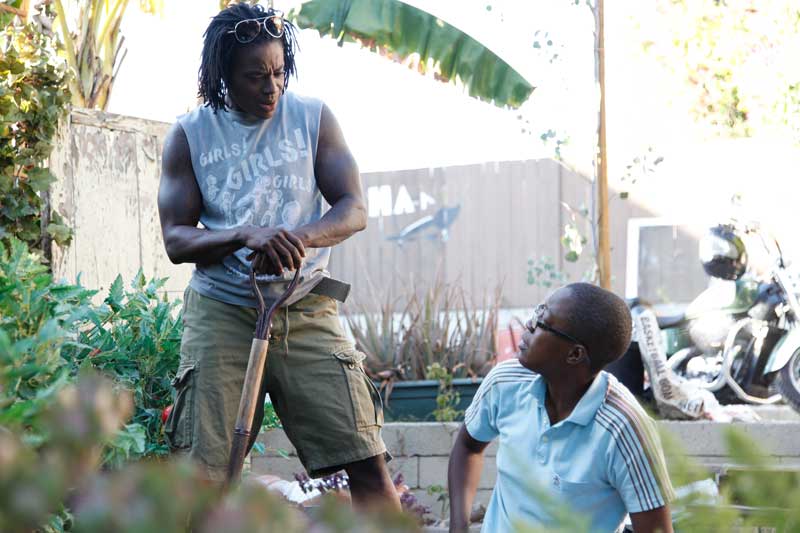|
The Paliament Film Collective's (Partial) Canon of Lesbian Cinema |
||||
 |
||||
Skye and Carol (Skyler Cooper and Cheryl Dunye). Still from The Owls (dir. Cheryl Dunye, 2010). Used with permission from the Parliament Film Collective. |
||||
The Parliament Film Collective's
(Partial) Canon of Lesbian Cinema
Page 2 of 3
Lucid describes an integrative, multiple style with enough space for both thinking hard and having fun. This “gay” sensibility is reflected in all three comments quoted above: a desire to push cinema to be as inclusive, rich, and radical as are the communities we seek and form.
Thus, while inserting gay characters into conventional forms (of production or genre) is undoubtedly a significant part of the queer film project, I think it becomes clear that this is not what our collective or film was about. This is not what I am naming our “lesbian collective aesthetic.” For our collective (as is true for many, come to think of it, if the collective is sharing power and authority and comes together from a celebration of difference) is more diverse, intelligent, and creative than mainstream culture allows. Thus, the Parliament Film Collective pressed against the repressive regimes of both the filmmaking industry (which insists that film can’t be made without large industrial backing and traditional hierarchies) and conventional genre (which insists that lesbians are pathological, shameful, and dangerous or perhaps merely pretty, perky, and quirky) to experiment with new forms to tell our innovative and untold stories. Our cinematographer, Alison Kelley, explains:
I’m not sure that I was influenced by lesbian/queer films. I did reference Cheryl's earlier work—She Don’t Fade (1991), Watermelon Woman (1995)—for the style of incorporating several simultaneous storylines, although with an eye to how to make this fresh and not just repeat what she had done in the nineties. I did like the nonlinear structure of Muriel (1963) by Alain Resnais. I felt that gave us an anchor to try some interesting image juxtaposition and creative blocking. I feel like the bigger influence photographically was more in that vein, of a surreal, thriller genre. I know that thematically Cheryl was influenced by The Killing of Sister George and The Fox, but these movies had much more of a classic Hollywood studio feel to the look of them. Given that we were shooting entirely on location and on a microbudget, I aimed for more naturalistic lighting with some very pointed compositional choices.
In our interactive interview, Cheryl and I recommend these lesbian/queer films as seminal: The Celluloid Closet and Fabulous! (for history), the works of Barbara Hammer (for experimental form), and those of Jean Carlomusto (for her long commitment to the queer media work of AIDS activism and lesbian empowerment).
Cheryl Dunye and Alex Juhasz at the Berlinale, part 2 [7:05]
In their conversations with me, the eleven featured members of the Collective add these further recommendations to our Partial Canon”: the collected works of Todd Haynes and Patricia Highsmith as well as these twenty-four titles (with commentary following):
All Over Me (dir. Alex Sichel, 1997)
B.D. Women (dir. Inge Blackman [now known as Campbell], 1994)
The Blossoming of Maximo Oliveros (dir. Auraeus Solito, 2005)
Celluloid Closet (dir. Rob Epstein and Jeffrey Friedman, 1995)
Fabulous! The Story of Queer Cinema (dir. Lisa Ades and Lesli Klainberg, 2006)
The Fox (dir. Mark Rydell, 1967)
Go Fish (dir. Rose Troche, 1994)
High Art (dir. Lisa Cholodenko, 1998)
Illusions (dir. Julie Dash, 1983)
Je Tu Il Elle (dir. Chantal Akerman, 1976)
Khush (dir. Pratibha Parmar, 1991)
Kids in the Hall (dir. John Fortenberry and Kevin McDonald, 1988-94)
The Killing of Sister George (dir. Robert Aldrich, 1964)
Looking for Langston (dir. Isaac Julien, 1988
Meshes of the Afternoon (dir. Maya Deren, 1943)
Muriel (dir. Alain Resnais, 1963)
Poison (dir. Todd Haynes, 1991)
Shatzi is Dying (dir. Jean Carlomusto, 2001)
She Don’t Fade (dir. Cheryl Dunye, 1991)
She Must be Seeing Things (dir. Sheila McLaughlin, 1987)
Stanger Inside (dir. Cheryl Dunye, 2001)
Superdyke (dir. Barbara Hammer, 1975)
The Watermelon Woman (dir. Cheryl Dunye, 1996)
Wittgenstein (dir. Derek Jarman, 1993)
Copyright © 2014. All rights reserved.